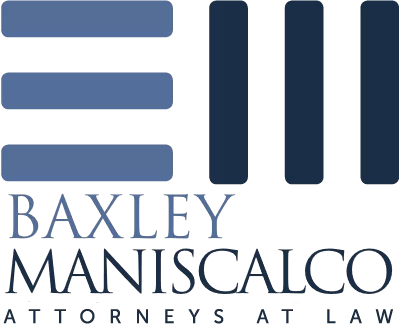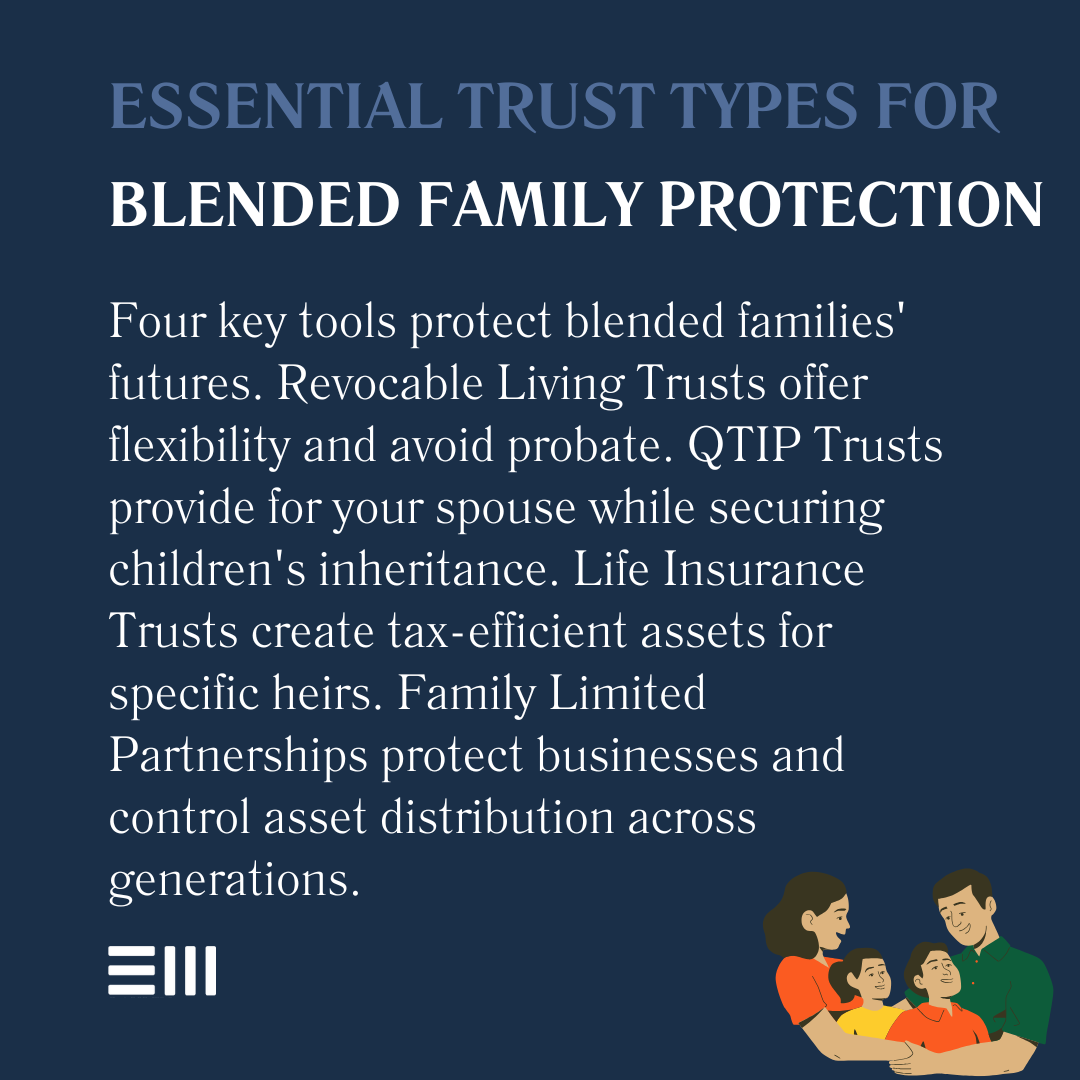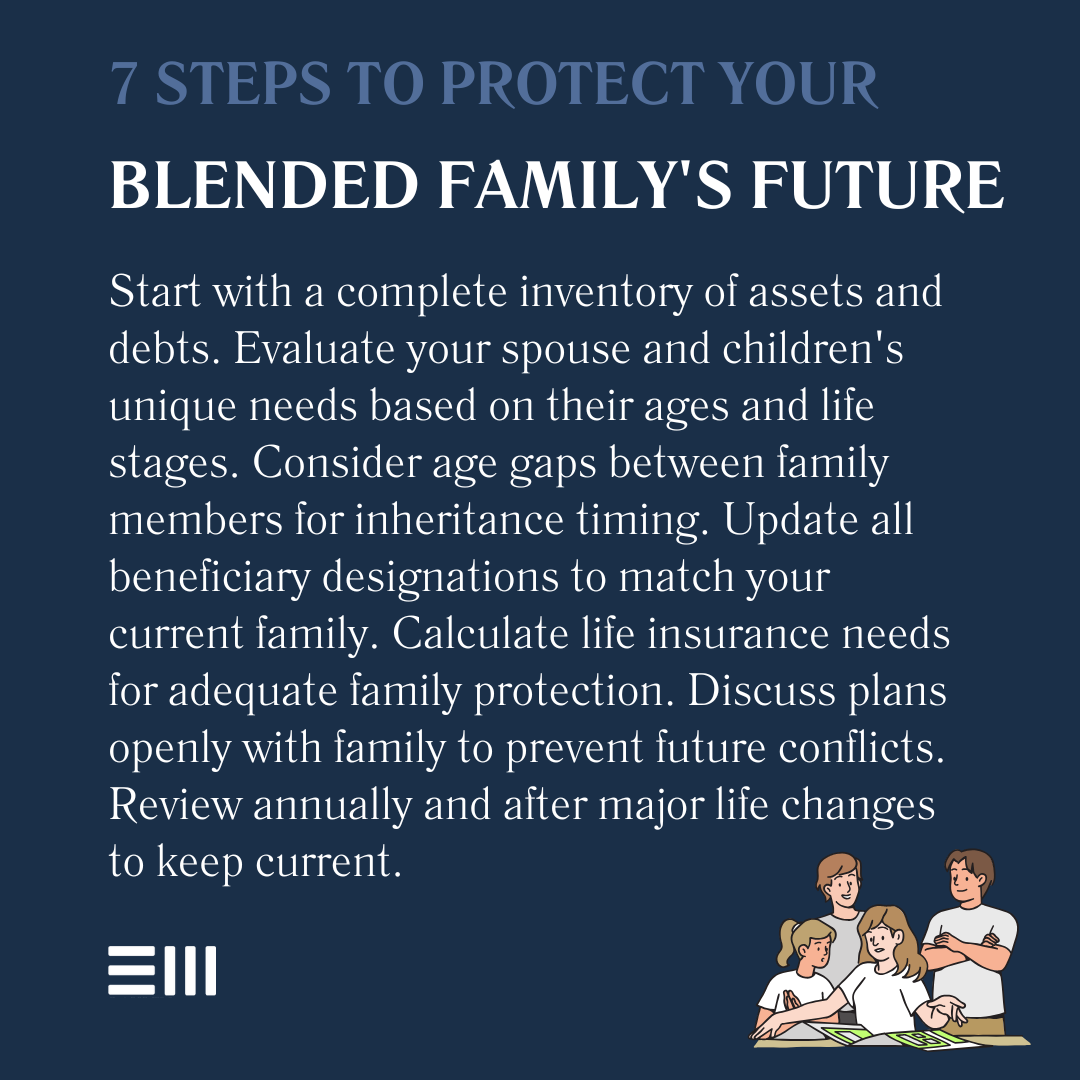Nearly 40% of American families are blended, combining children from previous relationships under one roof.
These modern family structures bring unique challenges to estate planning – where traditional approaches often fall short.
One misstep in estate planning can unintentionally disinherit children or create lasting family conflicts.
With over 1,300 new blended families forming every day in America, the need for specialized estate planning has never been more critical.
Understanding Estate Planning Challenges in Blended Families
Every blended family brings its own unique dynamics to estate planning.
The intricate web of relationships, emotions, and financial considerations requires careful navigation and thoughtful planning to ensure everyone's interests are protected.
- Prior marriages and divorce agreements that may impact current planning;
- Children from different relationships with varying needs and expectations;
- Complex family dynamics and relationships requiring diplomatic handling;
- Shared and separate assets accumulated before and during current marriage;
- Multiple beneficiary considerations across different generations;
- Potential conflicts between stepchildren and stepparents over inheritance;
- Balancing current spouse's needs with children's inheritance rights;
- Tax implications specific to blended family situations;
- Healthcare decisions and guardianship arrangements;
- Property ownership and transfer considerations;
- Family business succession planning; and
- Retirement account beneficiary designations.
These challenges require careful consideration and strategic planning to ensure fair treatment of all family members while maintaining family harmony.
Many families find that addressing these issues early helps prevent future disputes and ensures their wishes are properly documented.
Key Estate Planning Tools for Blended Families
Modern estate planning offers several powerful tools designed specifically to address the unique needs of blended families.
Understanding these options helps families make informed decisions about their legacy and ensure equitable distribution of assets.
Revocable Living Trusts
- Provides flexibility and control over asset distribution;
- Can be modified as family circumstances change;
- Helps avoid probate and maintain privacy; and
- Allows for specific conditions and timing of inheritances.
QTIP (Qualified Terminable Interest Property) Trusts
- Provides income for surviving spouse while protecting children's inheritance;
- Offers tax advantages for estate planning;
- Ensures final distribution according to first spouse's
- wishes; and
- Protects assets from future marriages or relationships.
Life Insurance Trusts
- Creates additional assets for specific beneficiaries;
- Provides tax-efficient wealth transfer;
- Helps equalize inheritances between different family members; and
- Offers flexibility in estate planning strategies.
Family Limited Partnerships
- Facilitates business succession planning;
- Provides tax advantages for wealth transfer;
- Allows for controlled distribution of assets; and
- Protects family assets from creditors.
Additional Planning Tools
- Prenuptial and Postnuptial Agreements;
- Pour-Over Wills;
- Living Wills and Healthcare Directives;
- Durable Powers of Attorney; and
- Special Needs Trusts when applicable.
Each of these tools serves a specific purpose in creating a comprehensive estate plan that protects all family members' interests and ensures smooth transition of assets.
Essential Steps in Creating Your Estate Plan
A successful estate plan for blended families requires careful consideration and systematic approach. Following these detailed steps helps ensure a comprehensive and effective plan.
Document all assets and liabilities
- Create detailed inventory of personal property;
- List all financial accounts and investments;
- Identify business interests and intellectual property; and
- Document debts and ongoing obligations.
Identify specific needs of spouse and children
- Consider age and life stage of all family members;
- Evaluate special needs or circumstances;
- Account for education and healthcare needs; and
- Plan for long-term care requirements.
Consider age differences between family members
- Plan for different life expectancies;
- Account for varying financial needs over time;
- Consider guardian arrangements for minor children; and
- Plan for adult children's inheritance timing.
Review existing beneficiary designations
- Update life insurance policies;
- Review retirement account designations;
- Check investment account beneficiaries; and
- Update property titles and deeds.
Evaluate life insurance needs
- Calculate future financial requirements;
- Consider tax implications and estate liquidity;
- Plan for business succession needs; and
- Account for educational expenses.
Discuss plans with family members
- Hold family meetings to explain intentions;
- Address concerns and questions;
- Maintain open communication; and
- Document discussions and decisions.
Regular plan review and updates
- Schedule annual reviews;
- Update after major life events;
- Adjust for changing tax laws; and
- Modify as family circumstances change.
Following these steps helps ensure nothing is overlooked in your estate planning process and provides a solid foundation for future modifications.
Common Questions About Estate Planning for Blended Families
Family dynamics can make estate planning complex. Here are detailed answers to questions we frequently hear from blended families seeking guidance.
How Do I Protect My Children's Inheritance?
Creating a trust with specific provisions for your children can ensure they receive their intended inheritance while still providing for your current spouse.
Consider using a QTIP trust or establishing separate trusts for different beneficiaries. The key is to clearly document your intentions and use legal tools that guarantee your wishes will be carried out.
What Happens to My Assets if I Die Without a Plan?
Without proper estate planning, state intestacy laws determine asset distribution, which may not align with your wishes.
Your current spouse might inherit everything, potentially leaving your children with nothing. State laws vary significantly, making it crucial to understand your local regulations and plan accordingly.
Should We Consider a Prenuptial Agreement?
Prenuptial agreements can play a vital role in estate planning for blended families. They help clarify financial responsibilities and inheritance rights before marriage, preventing future conflicts.
These agreements can also protect family businesses and ensure children from previous marriages receive their intended inheritance.
How Can We Prevent Family Disputes?
Clear communication, detailed documentation, and professional guidance are key to preventing disputes.
Consider family meetings to discuss estate plans and choose neutral executors or trustees when possible. Document all decisions and regularly review plans with all affected family members.
Asset Protection Strategies
Protecting assets while ensuring fair distribution requires careful planning. These strategies help balance the needs of all family members while preserving wealth for future generations.
Separate Property Agreements
- Define ownership of premarital assets;
- Establish clear boundaries for inheritance;
- Protect family businesses and heirlooms; and
- Document separate property contributions.
Marital Property Trusts
- Provide for current spouse;
- Protect children's inheritance;
- Offer tax advantages; and
- Allow for flexible distribution.
Generation-Skipping Trusts
- Preserve wealth for future generations;
- Minimize estate tax impact;
- Protect assets from creditors; and
- Maintain family legacy.
Family Limited Partnerships
- Control asset distribution;
- Provide tax benefits;
- Protect family businesses; and
- Facilitate succession planning.
Irrevocable Life Insurance Trusts
- Create tax-efficient inheritance;
- Provide immediate liquidity;
- Equalize inheritances; and
- Protect policy proceeds.
Each strategy offers unique benefits and should be carefully evaluated based on your family's specific circumstances and long-term goals.
Take the Next Step in Securing Your Family's Future
Your blended family deserves a thoughtful, comprehensive estate plan that protects everyone's interests.
Our experienced estate planning attorneys understand the unique challenges blended families face and can help create a customized plan that:
- Protects your spouse and children's financial future;
- Preserves family harmony through clear documentation;
- Minimizes tax implications for all beneficiaries;
- Prevents unintended disinheritance scenarios;
- Provides clear direction for asset distribution;
- Ensures healthcare wishes are respected;
- Protects family businesses and investments; and
- Creates lasting security for future generations.
Contact us today to schedule a consultation and take the first step toward securing your family's future.
Our team is ready to help you create an estate plan that gives you peace of mind and protects your loved ones for generations to come.


